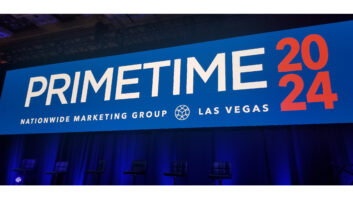TWICE: Fixed-lens models over $500 haven’t disappeared, but are they an endangered species?
Westfall: The volume of the business is just not there anymore. I mean, it’s going to continue. There’s probably going to be a fairly decent selection of high-end pieces from all the top players. And I think there is certainly still a percentage of customers who are interested in cameras like that for the reasons that we all know: being able to preview the picture before you shoot it, having an extended zoom range compared to what you could normally get in a digital SLR, and the movie-clip capability.
So there are certainly a lot of reasons for that product category to exist, but it just doesn’t look to us as if it’s going to be a real growth area.
Scott: I think for those of us that get into this space we need to, as Chuck was saying, really focus in on those things that make it different — video, certainly wider angle with a lot of optical zoom and a more compact body. To be successful in that limited space, which it is, you’d better focus on those things that deliver differentiation over digital SLR.
TWICE: What’s stopping that fixed-lens customer from spending an extra $100 for an SLR?
Giordano: I don’t know whether the customers have discovered [the high-end fixed-lens models] or not, but certainly at Nikon, we have three 8-meg cameras out there with ultra zoom lenses that offer tremendous value. If you were to make that system out of an SLR, it would cost you thousands and thousands and thousands of dollars.
The proliferation of film higher-zoom cameras came along because people didn’t want to carry a large SLR. It’s really funny how history is kind of repeating itself but in a different way. And customers will find those products, I think, in the long run.
Desmond: I think that both Bill and Chuck really nailed the question pretty accurately, but one point I would like to make, I think, is that the price point of SLRs is going to dictate the space. If you can offer a consumer at the appropriate price gap a great alternative at a price value, I think that is a limited space, but if you have the right product, and you’re at the right price point, and you have the right gap to an SLR, that there is space to be successful there. But it isn’t going to be a huge segment of the market.
Adams: I think we’re just about there, aren’t we? I mean, we’re at $800 for body and lens for entry-level digital SLR. If we’re talking about the leap from $500 to $800, we’re just about there, when the consumer is looking at the opportunity to expand their selection of lenses, their opportunity to get a little more creative. It’s a larger sensor, so even though the megapixel count might be the same or even less than a high-end compact, the image quality is much, much greater because the photo sensor is a lot larger. Certainly at Pentax, we’ve also concentrated on the size of the overall SLR product, making it much more compact, lighter weight, easier to carry it around — not too different from what you might call a super zoom-compact camera.
Westfall: When we brought out the Digital Rebel XT, I went back into my sample cabinet and pulled out a camera that we sold about three or four years ago called the PowerShot Pro 90. If you put them side to side, these things are virtually identical in terms of size. Just about everybody who’s coming out with SLRs [is] working towards making it more attractive, and part of that equation is making them nice and compact.
TWICE: How has the success of the d-SLR impacted your retail distribution?
Giordano: Well it’s amazing how the digital SLR has kind of given the traditional cameras stores a renaissance. All of a sudden, these guys are it. They have the huge selection. They’ve got the accessories. They have a knowledgeable sales staff. They’re the destination for serious photographers, people who are passionate about photography. They’re on a tremendous rebound here, but yet, the other players, the other channels, certainly want to take advantage of this opportunity that’s been presented to them. And so you have people who five years ago never would have considered stocking or selling SLRs of any kind now wanting those products.
Westfall: SLR marketing has gone toward a kit concept, where it used to be very much component oriented. And that, I think, is very intentional on the part of the manufacturers, because it allows them to distribute those products out to a greater range of dealers. You don’t necessarily have to have a highly educated sales force if you’ve got everything in one box that you can hand across the counter to the customer. That’s part of what’s going on, but certainly the traditional retailers, especially the people who had experience in SLR sales, have the greatest possibility to gain by the digital SLR business.
Zakrzewski: The kit factor, I agree with Chuck, makes it a little less scary for the consumer. They can see a box, that everything they need is in that box, and they can walk out of the store one time without having to make too many decisions about what they need to add on to this.













